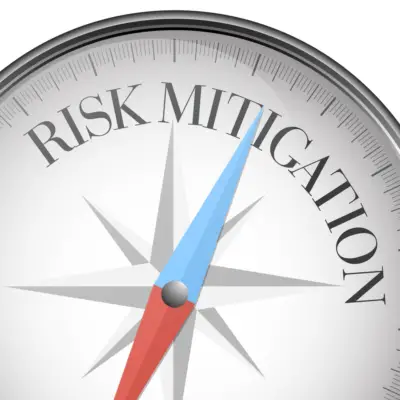Risk mitigation involves taking steps to reduce the adverse effects of potential risks. Here are some strategies to mitigate risk:
Risk Identification: The first step in mitigation is identifying potential risks. This can be done through various methods, such as brainstorming sessions, expert consultations, and risk assessment tools.
Risk Analysis: Once risks have been identified, they must be analyzed to understand their potential impact and likelihood. This can help prioritize which risks need to be addressed first.
Risk Evaluation: Evaluate the risk by comparing it against your risk criteria. Determine the level of risk and decide whether the risk is acceptable or if it needs treatment.
Risk Treatment: Develop a plan for treating or managing the risk. This could involve:
- Implement Controls: Implement the risk treatment plan and controls to manage the risk.
- Monitor and Review: Review the controls’ risk and effectiveness regularly. Adjust your risk management strategies as necessary.
- Communication and Consultation: Communicate with internal and external stakeholders throughout the risk management process.
Risk management is essential to have a plan to mitigate potential risks. This article will explain the steps involved in developing a risk management plan, such as identifying hazards, assessing risks, and implementing a hierarchy of controls.
It will also discuss cost considerations, regulatory requirements, and enforcement. Through this discussion, readers will understand the risk management process and how to ensure their organization is adequately prepared for worst-case scenarios.
Furthermore, the article will explain the risk management framework developed by the Australian National Audit Office (ANAO). This framework provides a comprehensive approach to understanding and mitigating risk.
Identifying Hazards
It involves assessing the potential risks in the business and determining the severity of the risks and the appropriate control measures to mitigate them.
Risk assessment is the process of analyzing the potential risks associated with a particular activity, and it involves looking at what could happen and the likelihood of it happening.
A hierarchy of control measures is used to rank ways of controlling the risk from the highest to the lowest level of protection and reliability.
Administrative controls and personal protective equipment are the least effective control measures, and the cost is a factor to consider when determining what is reasonably practicable to meet a health and safety duty.
The Model Code of Practice provides examples of the risk management process which can be used to identify and minimize potential hazards.
Risk evaluation is comparing risks against risk criteria such as severity, probability of occurrence, and effectiveness of control measures. This helps to determine which risks require treatment and the urgency of action.
Risk treatment is selecting and implementing appropriate measures to reduce risks to acceptable levels. This involves a combination of risk avoidance, risk reduction, risk transfer, and risk acceptance.
Once the risk treatment plan is in place, it is important to monitor and review it regularly to ensure it is effective.
The risk management process should be collaborative and involve all stakeholders. Workers and their health and safety representatives should be consulted at each step.
It is important to provide enough resources at all levels of the business and explain risk management to new employees and in training programs.
Proactive and open engagement with risk fosters a positive risk culture and enables the effective implementation of mitigation plans.
Risk Assessment
Analyzing potential hazards and estimating the likelihood of them occurring is essential in assessing risk. Risk assessment involves looking at the potential consequences of a hazard and the likelihood of it occurring to determine the level of risk.
The severity of the risk, the effectiveness of the control measures, and the urgency of action should be considered when assessing each risk. The hierarchy of control measures ranks the most effective from the highest to the lowest level of protection and reliability.
Administrative controls and personal protective equipment are the least effective control measures. Cost is also a factor to consider when determining what is reasonably practicable to meet a health and safety duty.
The Model Code of Practice provides examples of the risk management process. Risk assessment is an important part of the risk management process, and it is essential to ensure that the appropriate control measures are implemented to mitigate the risks.
Hierarchy of Controls
The hierarchy of controls ranks the most effective control measures from the highest to the lowest level of protection and reliability. It is a widely accepted approach to managing workplace risk and is used in many industries to reduce the risk of harm to workers and the wider community.
The hierarchy of controls is as follows:
- Elimination – the risk should be eliminated if it is reasonably practicable.
- Substitution – the risk should be substituted with a less hazardous one if it is reasonably practicable to do so.
- Engineering Controls are physical controls designed to reduce the risk of exposure to a hazard.
Administrative controls such as safe work procedures, training and supervision should be used to supplement and support the engineering controls. Personal protective equipment should only be used as a last resort as this is the least effective control measure. Cost should also be a factor in determining the most appropriate control measure.
The hierarchy of controls should be regularly reviewed to ensure that the chosen control measure is the most appropriate to reduce risk.
Cost Considerations
Cost should be considered when considering potential control measures to determine the most appropriate solution. Cost is a major factor in determining what is reasonably practicable to meet a health and safety duty. Table 1 outlines the cost considerations for the hierarchy of controls.
| Hierarchy of Control | Cost Considerations |
|---|---|
| Elimination | Highest cost |
| Substitution | Moderate cost |
| Engineering Controls | Moderate cost |
| Administrative Controls | Lowest cost |
| Personal Protective Equipment | Lowest cost |
The cost to implement control measures should be balanced with the measure’s effectiveness and the urgency of action. Risk assessments should be undertaken to ensure that the most cost-effective control measure is chosen.
Cost should not be the only factor considered when determining an appropriate control measure, as the potential damage and likelihood of an incident occurring should also be considered. The cost of implementing control measures should be weighed against the potential benefits that can be gained.
Regulation and Enforcement
Regulation and enforcement of Workers’ Health and Safety (WHS) laws are handled by the Commonwealth, states, and territories. WHS laws are established to protect workers from any physical or psychological risks in the workplace.
The Safety, Rehabilitation and Compensation Act 1988 (SRC Act) is the main legislation governing WHS in the Commonwealth. This Act is supported by the Safety, Rehabilitation and Compensation Regulations 2002 (SRC Regulations) and the Safety, Rehabilitation and Compensation (National Injury Insurance Scheme) Act 2013 (NIIS Act).
The WHS laws require employers to identify and manage hazards and risks in the workplace and provide a safe working environment for their employees. This includes assessing the severity of risks, the effectiveness of control measures, and determining the urgency of action.
The hierarchy of control measures ranks ways of controlling risks from the highest to the lowest level of protection and reliability. Administrative controls and personal protective equipment are the least effective control measures.
The costs involved in risk management should be considered when determining what is reasonably practicable to meet WHS duties. The Safety, Rehabilitation and Compensation Commission (SRCC) guides employers on the risk management process, including examples.
The SRCC also assists employers in ensuring that risk management processes are up-to-date and effective.
Frequently Asked Questions
What is the most effective approach to risk mitigation?
The most effective approach to risk mitigation is to identify, analyze, and evaluate potential risks and then develop a plan to treat them. The plan should include cost evaluations, risk criteria, and a rating system. It should be communicated to all stakeholders.
How can I ensure my risk management plan is effective?
An effective risk management plan should include risk identification, analysis, evaluation, treatment, and monitoring. It should also involve stakeholders, use a rating system, set objectives, and provide enough resources. Regular reviews should be conducted to ensure the plan is working.
What is the difference between risk assessment and risk analysis?
Risk assessment is the process of identifying and evaluating risks in a business. In contrast, risk analysis is assessing the severity of those risks and determining the most suitable course of action.
How often should I review my risk management plan?
Risk management plans should be reviewed regularly to ensure effectiveness and identify any business environment changes. It is recommended to review plans at least annually.
How do I know if my risk mitigation measures are adequate?
To determine if risk mitigation measures are adequate, one must assess the severity of the risk, the effectiveness of the control measures, and the urgency of action. Cost should also be considered when determining what is reasonably practicable to meet a health and safety duty.

Conclusion
Risk management is a vital component of any business or organization. Through a comprehensive risk management plan, businesses can mitigate risks and ensure their operations run smoothly and efficiently.
Risk assessment, hierarchy of controls, and cost considerations are important factors when developing a risk management plan. Regulation and enforcement are also essential to properly implement and adhere to risk management plans.
With a clear understanding of the risk management framework and process, businesses can confidently take the necessary steps to minimize and mitigate risk.

Chris Ekai is a Risk Management expert with over 10 years of experience in the field. He has a Master’s(MSc) degree in Risk Management from University of Portsmouth and is a CPA and Finance professional. He currently works as a Content Manager at Risk Publishing, writing about Enterprise Risk Management, Business Continuity Management and Project Management.



